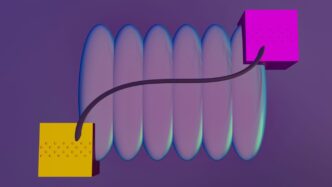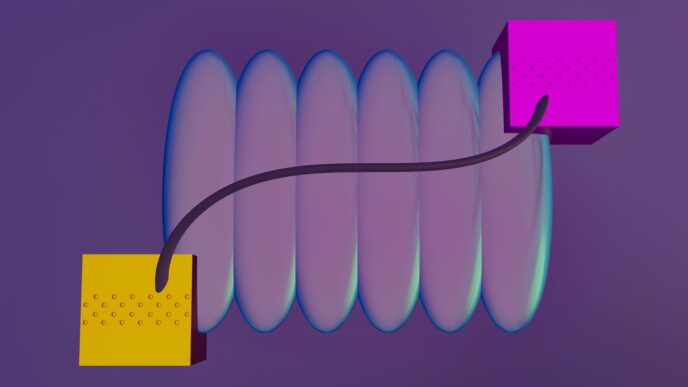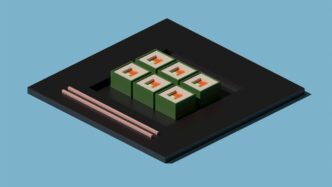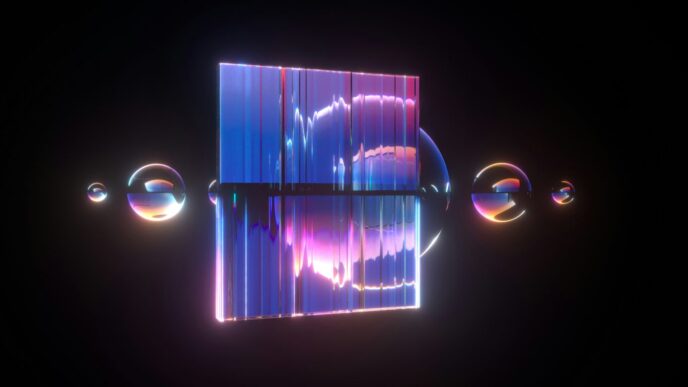Ever wondered about those mind-bending ideas in science fiction, like beaming people around? Well, the real science behind it, called quantum teleportation and entanglement, is just as wild, if not more so. It’s not quite like Star Trek yet, but these concepts are changing how we think about information and connection. We’re going to break down what quantum entanglement and teleportation really are, how they work, and why they matter for our future.
Key Takeaways
- Quantum entanglement links particles so they instantly affect each other, no matter the distance, a phenomenon Einstein called “spooky action at a distance.”
- Quantum teleportation moves a particle’s quantum state from one place to another without physically moving the particle itself.
- Entanglement is the backbone of quantum teleportation, enabling the transfer of quantum information.
- Experiments have successfully teleported quantum states using photons and atoms, with distances increasing over time.
- These technologies could lead to a secure quantum internet, more precise sensors, and unbreakable communication methods.
Understanding Quantum Entanglement and Teleportation
The Cosmic Connection: Defining Quantum Entanglement
So, what exactly is quantum entanglement? Imagine you have two coins, and you flip them. Normally, one landing heads doesn’t tell you anything about the other. But with entangled particles, it’s like flipping those coins and knowing that if one lands heads, the other must land tails, instantly, no matter how far apart they are. This interconnectedness is the heart of entanglement. It’s a bizarre link where the fate of one particle is tied to another, defying our everyday experience of how things should work. This isn’t just a theory; it’s something scientists have observed and measured.
Spooky Action at a Distance: Einstein’s View
Even Albert Einstein found this idea pretty strange. He famously called entanglement "spooky action at a distance." He wasn’t a big fan because it seemed to suggest that information could travel faster than light, which goes against his theory of relativity. It’s like having two gloves, one left and one right, separated by miles. The moment you look at one and see it’s a left glove, you instantly know the other is a right glove. But in the quantum world, it’s even weirder because the particles don’t have a definite state (like left or right) until you actually check them. This is where the spooky part comes in.
The Interdependence of Entangled Particles
When particles are entangled, their properties are linked. If you measure a certain characteristic of one particle, like its spin, you immediately know the corresponding characteristic of the other particle. This isn’t because they’re sending signals to each other; it’s because their states were linked from the moment they became entangled. Think of it like this:
- Creation: Two particles are created together in a special way.
- Separation: They are then moved far apart.
- Measurement: When you measure a property of one particle, its state becomes definite.
- Instantaneous Correlation: At that exact moment, the other particle’s state also becomes definite, in a way that’s perfectly correlated with the first measurement, no matter the distance. This is a key aspect of quantum teleportation.
This interdependence is what makes entanglement so powerful and so puzzling. It’s a fundamental aspect of how the universe works at its smallest scales.
The Science Behind Quantum Teleportation
So, how does this whole quantum teleportation thing actually work? It’s not like Star Trek, where people beam from one place to another. Instead, it’s about sending the state of a particle, like its spin or polarization, from one spot to another. Think of it like sending a very specific instruction manual, not the actual book.
Quantum Teleportation: Transmitting Quantum States
Basically, you have a particle, let’s call it Alice’s particle, and you want to send its exact quantum state to Bob, who is somewhere else. You can’t just measure Alice’s particle and tell Bob what you found, because measuring a quantum state usually messes it up. That’s where the magic of entanglement comes in. You need a pair of entangled particles, one for Alice and one for Bob. These particles are linked, no matter how far apart they are. When Alice interacts her particle with the particle whose state she wants to send, something interesting happens. This interaction, combined with a measurement Alice performs, changes the state of her original particle and, because of the entanglement, instantly affects Bob’s particle. Bob then performs a specific measurement on his particle, and based on Alice’s measurement results (which she has to send to him through normal means, like a phone call or email – no faster-than-light communication here!), he can adjust his particle to perfectly match the original state. It’s like having a secret handshake that allows you to perfectly replicate a message without ever seeing the original.
The Role of Entanglement in Teleportation
Entanglement is the absolute backbone of quantum teleportation. Without it, this whole process wouldn’t be possible. Imagine you have two coins that are magically linked. If one lands heads, the other must land tails, and vice versa, no matter how far apart they are when you flip them. That’s a simplified idea of entanglement. In teleportation, Alice uses her entangled particle to interact with the particle she wants to ‘teleport’. This interaction creates a correlation between Alice’s particles and Bob’s particle. When Alice measures her particles, the outcome tells her something about the original state she wanted to send, and it also instantly influences Bob’s particle. Bob’s particle, thanks to the entanglement, now holds a version of the original state, but it might be a bit scrambled. The information Alice sends about her measurement tells Bob how to unscramble his particle to get the exact original state. So, entanglement provides the necessary quantum link to transfer the state information indirectly.
The No-Cloning Theorem’s Importance
This is a really big deal in quantum mechanics. The no-cloning theorem basically says you can’t make an exact copy of an unknown quantum state. If you could, you could, for example, copy a secret key without anyone knowing. Quantum teleportation doesn’t violate this theorem because it’s not making a copy. Instead, it’s transferring the original state from one particle to another. The original particle’s state is essentially destroyed or altered in the process of transferring it. Think of it like moving a file from one computer to another by deleting it from the first one. You don’t have two identical files; you just have the file in a new location. This theorem is why we can’t just scan a person and beam them somewhere else like in sci-fi movies – you can’t perfectly copy all the quantum information that makes up a person. It’s a safeguard that keeps quantum information unique and secure.
Pioneering Experiments in Quantum Teleportation

So, how did scientists actually pull off this seemingly impossible feat? It wasn’t just a sudden breakthrough; it was a series of clever experiments building on each other.
Anton Zeilinger’s First Successful Teleportation
Back in 1997, a team in Austria, led by Anton Zeilinger, managed to do something pretty remarkable. They successfully teleported a quantum state from one photon to another. The trick involved entangling two photons first. Then, by measuring one of them, they could influence the state of the other, effectively transferring the quantum information. This was a huge step, proving that quantum teleportation wasn’t just a theoretical idea. It’s worth noting that Zeilinger, along with Alain Aspect and John Clauser, later received the Nobel Prize in Physics for their work on entangled photons, which really laid the groundwork for this field.
Advancements in Atom and Photon Teleportation
After Zeilinger’s initial success, the experiments got more sophisticated. In 2004, scientists at NIST and the University of Innsbruck managed to teleport information held by individual atoms. They used trapped beryllium ions, entangled them, and then teleported their quantum states. Later, in 2008, researchers in Tokyo sent quantum information across the city using optical fibers, covering several kilometers. These experiments showed that we could move quantum states over longer distances and with different types of particles.
Long-Distance Quantum Information Transfer
The push for longer distances continued. By 2015, a team at NIST had managed to transfer quantum information over 100 kilometers of optical fiber. That was a significant jump from previous attempts. These advancements are really what make things like a future quantum internet seem more plausible. The ability to send quantum states reliably over these distances is key to building a quantum internet.
Here’s a quick look at some milestones:
- 1997: First successful quantum state teleportation of a photon (Zeilinger’s team).
- 2004: Teleportation of quantum states between individual atoms (NIST/University of Innsbruck).
- 2008: Teleportation across several kilometers using optical fibers (University of Tokyo).
- 2015: Transfer of quantum information over 100 km of optical fiber (NIST).
Applications of Quantum Entanglement and Teleportation
So, what can we actually do with all this quantum entanglement and teleportation stuff? It’s not just for sci-fi movies, you know. These ideas are starting to show up in some pretty cool real-world applications.
First off, think about a quantum internet. This isn’t like the internet we use now. It would use quantum principles to send information in a way that’s incredibly secure. Imagine connecting quantum computers together, or having a network of quantum devices that can share information instantly and safely. It’s all about sending quantum states from one place to another without physically moving the particles themselves, which is a big deal for secure data transfer and distributed quantum computing. It’s like having a super-secret, super-fast messaging system.
Then there’s quantum sensing and metrology. We could make sensors and measurement tools way more precise. By teleporting quantum states of things like atoms or photons, we might get better results in measuring gravity, magnetic fields, or even keeping time. It’s about getting super-accurate readings that are hard to achieve with current technology.
And of course, secure communication channels. This is a big one. Using things like photons as carriers, we can set up secure quantum key distribution (QKD). This basically means creating encryption keys that are guaranteed to be safe from eavesdroppers. If anyone tries to listen in, the quantum properties change, and you know immediately. It’s a way to make sure your messages are truly private. This ability to transfer quantum information is a key part of building these new technologies, and it’s something scientists are actively working on transferring quantum information.
Here’s a quick rundown of what these applications mean:
- Quantum Internet: Connecting quantum computers and devices for secure, fast communication.
- Quantum Sensing: Creating highly sensitive measurement tools for science and industry.
- Secure Communication: Developing unbreakable encryption methods for sensitive data.
It’s pretty wild to think about how these strange quantum effects could change so much about how we communicate and measure things.
The Broader Implications of Quantum Phenomena
So, we’ve talked a lot about how entanglement and teleportation work, but what does it all mean for us, really? It’s not just some abstract science experiment happening in a lab somewhere. These ideas are actually starting to change how we think about the universe and what’s possible.
Entanglement’s Role in Quantum Computing
Think about computers. Right now, they use bits, which are either a 0 or a 1. Simple enough. But quantum computers use ‘qubits.’ Because of entanglement, a qubit can be a 0, a 1, or, get this, both at the same time. This is called superposition. When you entangle qubits, they become linked. If you know the state of one, you instantly know the state of the other, no matter how far apart they are. This allows quantum computers to do a lot of calculations all at once, which is why they could be way faster than our current computers for certain really tough problems, like discovering new medicines or breaking complex codes.
Challenging Classical Notions of Reality
This whole entanglement thing really messes with our everyday understanding of how things work. We’re used to things being in one place at a time, and that what happens here doesn’t instantly affect something miles away. But entanglement shows us that particles can be connected in a way that defies distance. It makes you wonder about the nature of reality itself. Is everything connected in ways we don’t yet grasp? It’s like the universe has these hidden connections that we’re only just starting to see.
Future Research Directions in Quantum Science
What’s next? Well, scientists are still digging into this stuff. They’re trying to figure out how to make entanglement and teleportation work over even longer distances, which is key for things like a quantum internet. They’re also looking at how these phenomena can make our measuring tools, like clocks or sensors, way more accurate. And, of course, there’s the ongoing work to make communication super secure using quantum methods. It feels like we’re just scratching the surface of what quantum mechanics can do.
So, What’s Next?
We’ve journeyed through the really strange world of quantum entanglement and teleportation. It’s pretty wild to think about particles being linked no matter how far apart they are, and how we can move quantum information without actually moving the particle itself. Scientists have been working on this for a while, with experiments showing it’s possible, and it’s not just science fiction anymore. This stuff could lead to super-secure communication, faster computers, and even better ways to measure things. It’s a big step in understanding how the universe works at its smallest levels, and it’s exciting to see what new discoveries come next.
Frequently Asked Questions
What exactly is quantum entanglement?
Imagine you have two special coins that are linked. If you flip one and it lands on heads, you instantly know the other one, no matter how far away, landed on tails. Quantum entanglement is like that, but with tiny particles. When particles are entangled, they’re connected in a way that knowing something about one tells you something about the other, instantly, even across vast distances.
How is quantum teleportation different from sci-fi teleportation?
Quantum teleportation isn’t like in the movies where a whole person disappears and reappears somewhere else. Instead, it’s about sending the exact state or properties of a tiny particle, like its spin or energy, from one place to another. This is done using entanglement and without physically moving the particle itself.
Does entanglement play a role in quantum teleportation?
Yes, entanglement is super important for quantum teleportation! Think of it as the special link that allows the information about a particle’s state to be transferred. Without this ‘cosmic connection,’ teleporting the state wouldn’t be possible.
Has quantum teleportation been done in real experiments?
Scientists have successfully teleported the quantum states of tiny things like photons (particles of light) and atoms. They’ve done this over increasingly longer distances, showing that this strange connection can be used to move information in new ways.
What are some future uses for quantum teleportation and entanglement?
One of the biggest goals is to build a super-secure ‘quantum internet.’ This would use quantum principles like teleportation to send information in a way that’s impossible to hack. It could also lead to much more sensitive measuring tools and faster, more powerful computers.
What is the ‘no-cloning theorem’ and why does it matter?
The ‘no-cloning theorem’ is a rule in quantum physics that says you can’t make an exact copy of a quantum state. This is important because it means we can’t just peek at a quantum particle’s state and then recreate it perfectly elsewhere. Teleportation works around this by transferring the original state, not copying it.














